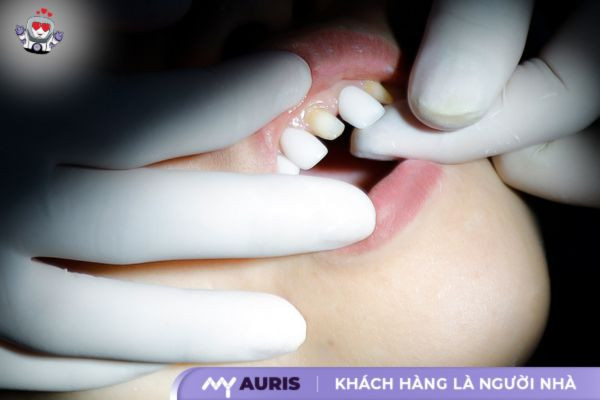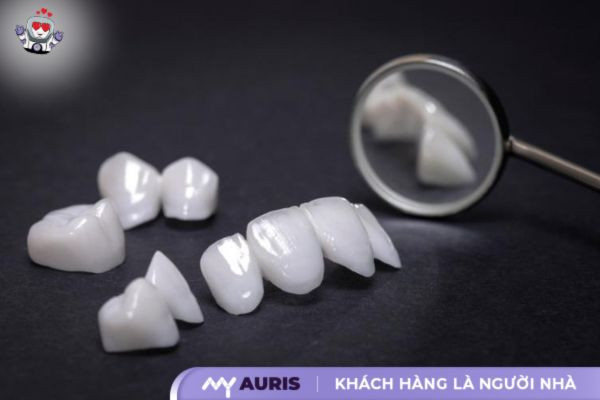Do you want to have bright, white, beautiful teeth and a radiant smile? Porcelain dental technology is an effective solution to help you realize that dream. Porcelain dental technology is part of the dental restoration process, using porcelain crowns or porcelain dental veneers to cover the surface of real teeth, creating artificial teeth with the same shape, color and function as real teeth. This article will provide detailed information about the technique of making porcelain teeth, from definitions, common types of techniques, advantages and disadvantages, implementation procedures, costs to how to care for porcelain teeth after making them.
Learn about the technique of making porcelain teeth
The technique of making porcelain teeth is part of the dental restoration process, helping to replace or restore damaged teeth, missing teeth, or create more beautiful teeth. The technique of making porcelain teeth uses porcelain crowns or porcelain veneers to cover the surface of real teeth, creating fake teeth with the same shape, color and function as real teeth. Porcelain tooth making technique is widely used in dentistry to restore chewing function, improve tooth aesthetics and preserve real teeth.
Porcelain tooth making technique has many different methods, each method has its own advantages and disadvantages. Choosing the appropriate technique to make porcelain teeth is important to ensure treatment effectiveness, bring the best results and be suitable for the patient’s oral condition.
The technique of making porcelain teeth is What?
The porcelain dental technique is a dental treatment method used to restore and improve the aesthetics of teeth. Porcelain tooth making technique includes creating a porcelain tooth shell or porcelain tooth veneer to cover the surface of real teeth, creating false teeth with shape, color and function similar to real teeth.
Porcelain tooth making technique is often used in the following cases:
- Severe tooth decay, chewing function needs to be restored.
- Fractured, chipped or broken teeth need to be restored to shape.
- Teeth are discolored or discolored.
- Teeth are worn or misaligned.
- Missing teeth, need denture restoration.
- Need to improve dental aesthetics, create a radiant smile.
Ceramic dental technology is a safe and effective solution for tooth restoration, giving patients a confident smile and healthy teeth.

Popular types of porcelain teeth making techniques
Porcelain tooth making techniques there are many different types, each type has its own characteristics, suitable for each specific case. Below are some techniques. Popular porcelain tooth making technique today:
- CAD/CAM porcelain tooth making technique: uses computer technology to design and manufacture porcelain teeth, helping to create porcelain teeth with high precision, beautiful shape and natural color.
- Technology for making porcelain teeth without grinding enamel: Maximum preservation of real teeth, suitable for cases where teeth are worn, discolored or slightly changed in shape.
- Technique for making porcelain teeth: is a quick and minimally invasive method, often used to improve the aesthetics of teeth that are chipped, chipped, crooked or have changed color.
- Aesthetic porcelain teeth technique: focuses on aesthetic factors, creating porcelain teeth with beautiful shapes and natural colors and suitable for the patient’s face.
- Zirconium porcelain tooth making technique: uses zirconia ceramic material with high durability, abrasion resistance and good strength, suitable for cases that need to restore teeth subjected to strong chewing forces.
In addition, depending on the type of porcelain teeth used, the technique of making porcelain teeth is also classified as follows:
- Metal porcelain teeth: is a type of porcelain tooth with a metal core covered with an outer layer of porcelain. This type of porcelain tooth has a low price, but is not naturally beautiful and easily blackens. gum line.
- All-ceramic teeth: are made entirely of porcelain, are highly aesthetic, naturally beautiful and do not blacken the gum line. id=”Uu_diem_va_nhuoc_diem_cua_tung_ky_thuat”>Advantages and disadvantages of each technique
Ceramic tooth making technique is a safe and effective solution for restoration teeth, but each technique has its own advantages and disadvantages.
CAD/CAM porcelain teeth technique:
- Advantages:
- High precision, beautiful shape and natural color.
- Save dental work time.
- Less causes damage to real teeth.
- Disadvantages:
- Higher cost than traditional porcelain teeth technique.
- Not suitable for cases requiring complex tooth shaping.
Technology for making ceramic teeth without grinding enamel:
- Advantages:
- Maximum preservation of natural teeth.
- Minimally invasive.
- Suitable for cases where teeth are worn, discolored or slightly changed in shape.
- Disadvantages:
- Only suitable for cases of mildly damaged teeth.
- Durability is not as high as other types of porcelain teeth.
Technology for making porcelain veneers:
- Advantages:
- Quick and minimally invasive method.
- Suitable for cases where teeth are chipped, chipped, crooked or have changed color.
- High durability and natural color.
- Disadvantages:
- Not suitable for cases of severely damaged teeth.
- Higher cost than traditional porcelain tooth making technique.
Aesthetic porcelain tooth making technique:
- Advantages:
- Focuses on aesthetic factors, creating porcelain teeth with beautiful shapes and natural colors.
- Suitable for cases that need to improve dental aesthetics.
- Disadvantages:
- The cost is higher than other porcelain teeth making techniques.
Zirconium porcelain teeth making technique:
- Advantages:
- High durability, abrasion resistance and good strength.
- No blackening of the gum line.
- Natural color.
- Disadvantages:
- High cost.
- Difficult to create complex tooth shapes.
Process of making porcelain teeth
Process of making teeth Porcelain is a series of steps taken to restore and improve the aesthetics of teeth, helping patients have healthy teeth, a brighter smile and more confidence. The process of making porcelain teeth includes many steps, from examination and consultation to making and attaching porcelain teeth. Each step is important and affects the final results of the treatment process.
Examination and consultation
The first step in the porcelain tooth making process is examination and consultation. The patient will be examined by a dentist, checking the oral condition, determining the cause and extent of tooth damage.
Teeth preparation
After examination and consultation, the dentist will prepare the teeth before making porcelain teeth.
Taking tooth impressions
Taking tooth impressions is an important step in the process of making porcelain teeth, helping to create molds for porcelain teeth.
Making porcelain teeth
After taking the tooth impression, the tooth mold will be sent to the technical room to make porcelain teeth.
Porcelain teeth attached
After the porcelain tooth is made, the dentist will attach the porcelain tooth to the real tooth.

Attaching porcelain teeth to real teeth Choose the appropriate technique for making porcelain teeth
Choose a technique for making teeth Appropriate porcelain is an important step in the porcelain dental process, helping to ensure treatment effectiveness, bring the best results and be suitable for the patient’s oral condition. Techniques for making porcelain teeth there are many different types, each with its own advantages and disadvantages.
Determining dental condition
The first step in choosing a porcelain dental technique is to determine your oral condition.
Determining aesthetic goals
Aesthetic goals is also an important factor in Choosing the technique to make porcelain teeth.
Determining your budget
Budget is an important factor when you Choose the technique of making porcelain teeth. You can discuss with your dentist about your budget to choose the appropriate technique of making porcelain teeth.
Dentist’s advice
Dentist’s consultation is the most important step in choosing a porcelain dental technique.

Consultation before dental work Compare techniques for making porcelain teeth
Dental making techniques Porcelain has many different types, each type has its own advantages and disadvantages, suitable for each specific case. Patients should learn carefully about these techniques to choose the method that best suits their dental condition and wishes.
CAD/CAM porcelain dental technique and traditional porcelain tooth making technique
CAD/CAM porcelain tooth making technique: uses computer technology to design and manufacture porcelain teeth, helping to create porcelain teeth with high precision, beautiful shape and natural color.
Making technique Traditional porcelain teeth: is a manual technique of making porcelain teeth, using molds to shape porcelain teeth.
Compare two techniques:
Technique Advantages Disadvantages points CAD/CAM porcelain tooth making technique High precision, beautiful shape, natural color, saves time Higher cost, not suitable for complex teeth complex Traditional porcelain tooth making techniques Lower cost, suitable for complex teeth cases Lower precision, not as beautiful shape, prone to blackening of gum line CAD/CAM porcelain tooth making technique is being used more commonly because of its outstanding advantages in accuracy and aesthetics. However, Traditional porcelain tooth making technique is still used in some special cases, due to lower costs.
Technique for making porcelain teeth without grinding enamel and technique for making porcelain teeth with grinding enamel
Technique for making porcelain teeth without grinding enamel: is a technique that maximizes preservation of real teeth, requiring only a thin layer of enamel or no need to grind enamel.
The technique of making ceramic teeth with enamel grinding: is a technique that requires grinding real tooth enamel to shape porcelain teeth.
Compare two techniques:
Technique Advantages Points Disadvantages Technology of making ceramic teeth without enamel grinding Maximum preservation of real teeth, minimally invasive, suitable for cases of worn, dull teeth Only suitable for cases of damaged teeth Light injury, not as high durability Technology of making ceramic enamel grinding Higher durability, suitable for severely damaged teeth, good bearing force Causes damage to real teeth, can cause sensitivity, not high durability by The technique of making ceramic teeth without enamel grinding is the preferred choice in cases of mildly damaged teeth, helping to preserve the maximum amount of real teeth. The technique of making ceramic enamel teeth is used in cases where teeth are severely damaged and need to restore chewing function.
Technology for making porcelain veneers and technique for making porcelain veneers
Technology for making porcelain veneers: is a technique that uses porcelain dental veneers to cover the surface of real teeth, helping to improve the aesthetics of teeth that are chipped, chipped, crooked or change color. sharp.
Ceramic overlay technique: is a technique that uses porcelain crowns to cover the entire surface of real teeth, helping to restore teeth that are decayed, broken, worn, or changed in shape.
Compare the two techniques. Technique:
Technique Advantages Disadvantages Technology for making porcelain veneers Quick, minimally invasive, highly aesthetic method, suitable for cases of chipped teeth, chip Not suitable for severely damaged teeth, not as durable as Ceramic coating technique Higher durability, suitable for severely damaged, force-bearing teeth good Causes damage to real teeth, can cause sensitivity, not as durable Technology for making porcelain veneers is preferredFirst choice in cases where teeth are slightly damaged and need to improve aesthetics. Ceramic tooth coating technique is used in cases where teeth are severely damaged and need to restore chewing function.
Cost Making porcelain teeth using different techniques: Instructions for patients
The cost of making porcelain teeth is one of the important factors that patients need to consider before deciding to perform the porcelain tooth making process. The cost of making porcelain teeth depends on many factors, from the type of porcelain teeth, the technique of making porcelain teeth, to the geographical location and reputation of the dental clinic.
Factors affecting cost
Cost of porcelain teeth is calculated based on the following factors:
- Type of porcelain teeth:
- Metal ceramic teeth: are ceramic teeth with a metal core covered with a ceramic layer on the outside. This type of porcelain teeth has a lower price than other types of porcelain teeth.
- All-ceramic porcelain teeth: are made entirely of porcelain, are highly aesthetic, naturally beautiful and do not blacken the gum line. This type of porcelain teeth has a higher price than metal porcelain teeth.
- Zirconium porcelain teeth: are porcelain teeth made from zirconia ceramic material with high durability, abrasion resistance and good strength. This type of porcelain teeth has the highest price among all types of porcelain teeth.

The type of porcelain teeth the customer chooses is the deciding factor in the cost of dental work - Ceramic tooth making techniques:
- CAD/CAM porcelain tooth making technique: is a technique that uses computer technology to design and manufacture porcelain teeth, helping to create porcelain teeth with high precision, beautiful shape and natural color. This technique has a higher cost than the traditional porcelain tooth technique.
- Traditional porcelain tooth making technique: is a manual porcelain tooth making technique, using molds to shape porcelain teeth. This technique has a lower cost than the CAD/CAM porcelain dental technique.
- Number of porcelain teeth: The cost of making porcelain teeth will increase according to the number of porcelain teeth neededn do.
- Geographical location: The cost of porcelain teeth in big cities is often higher than in rural areas.
- Reputation of the dental clinic: Reputable dental clinics, modern equipment and a team of experienced dentists often have higher costs than normal dental clinics.
Comparison table of prices for making porcelain teeth using different techniques
Below is a price comparison table for making porcelain teeth using different techniques Different techniques in Vietnam (price may vary depending on each dental clinic):
Type of porcelain teeth Technology of making porcelain teeth Price (VND) Metal porcelain teeth type Traditional porcelain tooth making technique From 1,000,000 – 2,000,000 Full porcelain teeth porcelain Traditional porcelain tooth making techniques From 2,000,000 – 5,000,000 Porcelain teeth zirconia CAD/CAM porcelain teeth making technique From 5,000,000 – 10,000,000 Caring for porcelain teeth after making them
Caring for porcelain teeth properly after making porcelain teeth is very important to ensure durable and beautiful porcelain teeth, maintaining chewing function and long-term aesthetics. Patients need to follow the dentist’s instructions to effectively care for porcelain teeth.
Daily oral hygiene
Daily oral hygiene day is the most important step in taking care of porcelain teeth. Patients should:
- Brush your teeth twice a day: Use a soft toothbrush, fluoride toothpaste, and proper brushing technique.
- Flossing: Removes food scraps and plaque from places a toothbrush cannot reach.
- Rinse with mouthwash: Helps eliminate bacteria and clean the oral cavity.
- Use porcelain teeth cleaning tools: Use specialized cleaning tools for porcelain teeth such as super soft toothbrushes, interdental brushes, to clean hard-to-reach places.
- Limit the use of hard, chewy foods dpicture: These foods can wear down or break porcelain teeth.
- Do not use your teeth to bite, open bottle caps, or cut hard foods: This can cause porcelain teeth to break.

Clean your teeth every day to take care of your porcelain teeth Regular check-ups
Regular inspection is a necessary step to detect porcelain tooth problems early and treat them promptly.
- Patients should visit the dentist for regular check-ups every 6 months: The dentist will check the condition of the porcelain teeth, professionally clean teeth and advise on how to effectively care for porcelain teeth.
- Check the fit of the porcelain teeth: If the porcelain teeth are loose, you need to go to a dentist to check and adjust.
- Check the color of porcelain teeth: If porcelain teeth are tarnished, you need to go to the dentist to polish or replace them.
Avoid habits bad
Some bad habits can affect the longevity of porcelain teeth, patients need to limit:
- Chewing foods that are too hard or chewy: Can wear down or break porcelain teeth.
- Using teeth to bite, open bottle caps, or cut hard foods: Can cause porcelain teeth to break.
- Chewing gum too much: Gum can clog between teeth, creating conditions for bacteria to grow, causing gingivitis.
- Using teeth to open bottle caps: Can break porcelain teeth.
- Using teeth whitening products: Can cause discoloration or breakage of porcelain teeth.
Ceramic tooth whitening technique is an effective method to restore teeth, improve aesthetics and bring you a confident smile. Choosing the appropriate technique for making porcelain teeth, performing the procedure properly and taking care of porcelain teeth after treatment is very important to ensure treatment effectiveness and prolong the life of porcelain teeth. My Auris Dental with a team of professional, experienced and knowledgeable dentistsModern equipment, committed to providing customers with high quality porcelain dental services, ensuring safety and effectiveness. My Auris Dental Clinic always puts customers’ interests first, considers customers as family members, bringing absolute satisfaction and trust.
- Advantages:





